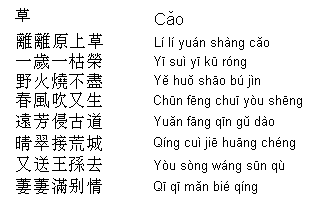 |
Part part plain on grass The grass is spreading out across the plain,
One year one wither flourish Each year, it dies, then flourishes again.
Prairie fire burn not destroy It's burnt but not destroyed by prairie fires,
Spring wind blow again life When spring winds blow they bring it back to life.
Distant fragrance invade old path Afar, its scent invades the ancient road,
Clear emerald meet ruined town Its emerald green overruns the ruined town.
Again see off noble friend go Again I see my noble friend depart,
Crowded full parting feeling I find I'm crowded full of parting's feelings.
One year one wither flourish Each year, it dies, then flourishes again.
Prairie fire burn not destroy It's burnt but not destroyed by prairie fires,
Spring wind blow again life When spring winds blow they bring it back to life.
Distant fragrance invade old path Afar, its scent invades the ancient road,
Clear emerald meet ruined town Its emerald green overruns the ruined town.
Again see off noble friend go Again I see my noble friend depart,
Crowded full parting feeling I find I'm crowded full of parting's feelings.
The main theme about this poem is "Parting". It basically says that when you part with somebody, they will come back. The structure is very simple. There are only five characters on every line, but every line actually says a lot. The poem uses many different objects as a metaphor for his friend.
source : http://www.chinese-poems.com/bo4t.html